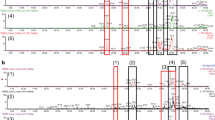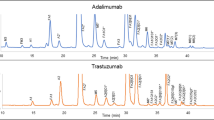Abstract
Released N-glycan analysis using the fluorescent label 2-AB (2-aminobenzamide) has been the “gold standard” method for released glycan analysis for several years. The more recent RapiFluor-MS™ labeling technique, however, offers enhanced mass spectrometric detection of released N-glycans, improving the sensitivity and detection limits of the method. The optimized multidimensional detection offers increased confidence in glycan identification which can be further supported by an exoglycosidase digestion array (optional). Here we describe the PNGase F release of N-glycans from a typical IgG1 monoclonal antibody (mAb) with subsequent labeling with RapiFluor-MS™ for detection by HILIC-FLR-MS. The method output quantifies the relative proportion of each glycan species including core afucosylation, sialylation, and high-mannose content, and has a limit of detection (LOD) of 0.01% relative abundance.
Access this chapter
Tax calculation will be finalised at checkout
Purchases are for personal use only
Similar content being viewed by others
References
Leymarie N, Zaia J (2012) Effective use of mass spectrometry for glycan and glycopeptide structural analysis. Anal Chem 84:3040–3048. https://doi.org/10.1021/ac3000573
Yamane-Ohnuki N, Satoh M (2009) Production of therapeutic antibodies with controlled fucosylation. MAbs 1:230–236. https://doi.org/10.4161/mabs.1.3.8328
Jefferis R (2005) Glycosylation of recombinant antibody therapeutics. Biotechnol Prog 21:11–16. https://doi.org/10.1021/bp040016j
Beck A, Wagner-rousset E, Ayoub D et al (2013) Characterization of therapeutic antibodies and related products. Anal Chem 85:715–736
Goetze AM, Liu YD, Zhang Z et al (2011) High-mannose glycans on the Fc region of therapeutic IgG antibodies increase serum clearance in humans. Glycobiology 21:949–959. https://doi.org/10.1093/glycob/cwr027
Reusch D, Tejada ML (2015) Fc glycans of therapeutic antibodies as critical quality attributes. Glycobiology 25:1325–1334. https://doi.org/10.1093/glycob/cwv065
Okazaki A, Shoji-Hosaka E, Nakamura K et al (2004) Fucose depletion from human IgG1 oligosaccharide enhances binding enthalpy and association rate between IgG1 and FcγRIIIa. J Mol Biol 336:1239–1249. https://doi.org/10.1016/j.jmb.2004.01.007
Shields RL, Lai J, Keck R et al (2002) Lack of fucose on human IgG1 N-linked oligosaccharide improves binding to human FcGammaRIII and antibody-dependent cellular toxicity. J Biol Chem 277:26733–26740. https://doi.org/10.1074/jbc.M202069200
Fernandes D (2005) Demonstrating comparability of antibody glycosylation during biomanufacturing. Eur Biopharm Rev:106–110
Zhang P, Woen S, Wang T et al (2016) Challenges of glycosylation analysis and control: an integrated approach to producing optimal and consistent therapeutic drugs. Drug Discov Today 21:740–765. https://doi.org/10.1016/j.drudis.2016.01.006
Keser T, Pavic T, Lauc G, Gornik O (2018) Comparison of 2-aminobenzamide, procainamide and RapiFluor-MS as derivatizing agents for high-throughput HILIC-UPLC-FLR-MS N-glycan analysis. Front Chem 6:1–12. https://doi.org/10.3389/fchem.2018.00324
Lauber MA, Yu Y-Q, Brousmiche DW et al (2015) Rapid preparation of released N-glycans for HILIC analysis using a labeling reagent that facilitates sensitive fluorescence and ESI-MS detection. Anal Chem 87:5401–5409. https://doi.org/10.1021/acs.analchem.5b00758
Author information
Authors and Affiliations
Corresponding author
Editor information
Editors and Affiliations
Rights and permissions
Copyright information
© 2021 Springer Science+Business Media, LLC, part of Springer Nature
About this protocol
Cite this protocol
Upton, R., Duffy, J., Clawson, S., Firth, D. (2021). Evaluating N-Glycosylation of a Therapeutic Monoclonal Antibody Using UHPLC-FLR-MS with RapiFluor-MS Labeling. In: Delobel, A. (eds) Mass Spectrometry of Glycoproteins. Methods in Molecular Biology, vol 2271. Humana, New York, NY. https://doi.org/10.1007/978-1-0716-1241-5_14
Download citation
DOI: https://doi.org/10.1007/978-1-0716-1241-5_14
Published:
Publisher Name: Humana, New York, NY
Print ISBN: 978-1-0716-1240-8
Online ISBN: 978-1-0716-1241-5
eBook Packages: Springer Protocols




